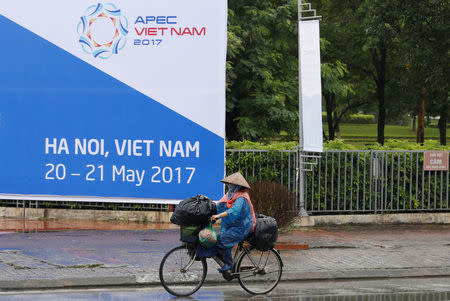TPP trade deal members seek to move ahead without U.S.
By Mai Nguyen and A. Ananthalakshmi HANOI (Reuters) - Remaining members of the Trans Pacific Partnership (TPP) free trade agreement are working on a statement to reaffirm their commitment to it, despite the withdrawal of the United States, sources close to the discussions said. Some still hope for the eventual return of the United States to the deal ditched by U.S. President Donald Trump, because of his readiness to shift position on other issues, Malaysia's trade minister said. Talks are happening on the sidelines of an Asia-Pacific Economic Cooperation (APEC) meeting, the biggest trade gathering since Trump upended the world order with his "America First" policy. The competing visions are evident at this weekend's APEC meeting of ministers from countries that account for well over 40 percent of world trade. While new U.S. Trade Representative Robert Lighthizer will hold bilateral talks with key countries, China will be pushing its favoured Asian trade agreement as it puts itself forward as a global free trade champion. Japan is leading the countries that still want to persist with the much more comprehensive TPP agreement, abandoned by Trump in one of his first acts in office and which does not include China. Sources close to the discussions said the so-called TPP-11 nations - the 11 left after the United States withdrew - were planning a statement of commitment to the pact. "There will be two main points: 1. To aim for an early entry into force of the TPP-11, 2. To bear in mind an environment where a signatory country can return," said one source close to the discussions who was not authorised to speak to the media. The agreement is due to take effect next year. CHALLENGES Among the challenges is keeping on board Vietnam and Malaysia, which would have been big beneficiaries from the agreement if it included the United States. Some renegotiation would be needed for the deal to proceed without the United States, Malaysian Trade Minister Mustapa Mohamed told Reuters. A Vietnamese official expressed a similar view. Mustapa said there was optimism the United States would return one day, because Trump had shown readiness to shift his position on other matters, such as softening his stance towards China. "There has been less rhetoric and a more realistic approach," he said. However, renegotiating the existing North America Free Trade Agreement (NAFTA) is a bigger immediate priority for Washington. In Hanoi, Lighthizer is due to hold two-way meetings to start making official contact with key trade officials. Nearly all the other 20 members of APEC had requested bilateral meetings, U.S. officials said. Main countries are China, Japan and South Korea, with which Trump wants to renegotiate a free trade deal. Canada and Mexico will be at the Asia-Pacific meetings and are also in the North American trade area. In other talks on the sidelines, China will be driving for progress on its favoured trade deal for Asia: the Regional Comprehensive Economic Partnership. The free trade agreement doesn't cover as many areas as the TPP deal or demand tough conditions for members on issues such as protecting intellectual property, labour rights or the environment. Officials said there remained significant points of disagreement in the talks between Southeast Asian countries, China, India, Australia, New Zealand, Japan and South Korea. The United States has never been part of those discussions. Given the uncertainty over TPP, the China-backed deal was now the priority for Malaysia, Mustapa said. (Writing by Matthew Tostevin; Editing by Clarence Fernandez)

 Yahoo News
Yahoo News 

